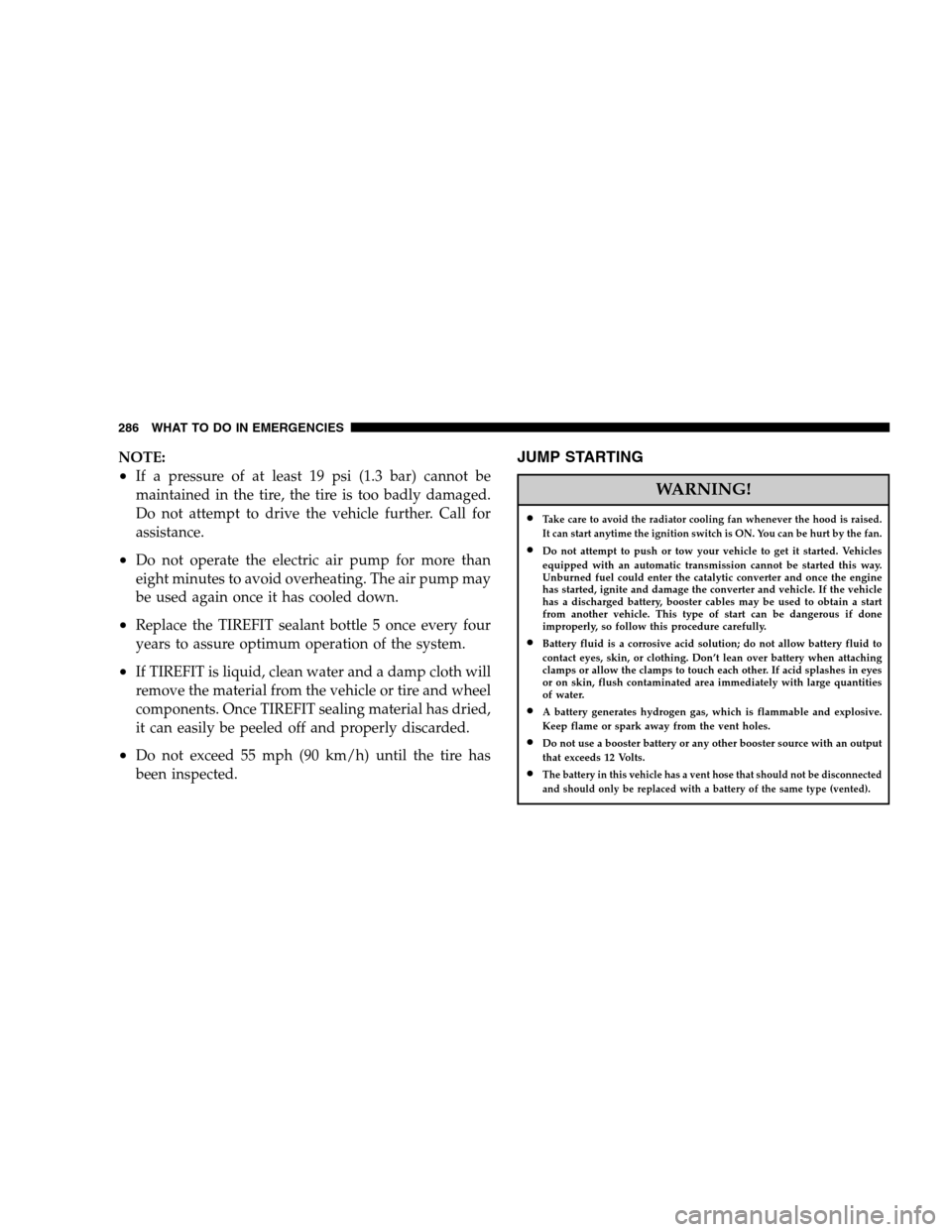Page 231 of 381

Shallow Standing Water
Although your vehicle is capable of driving through
shallow standing water, consider the following Caution
and Warning before doing so.
CAUTION!
•Always check the depth of the standing water
before driving through it. Never drive through
standing water that is deeper than the bottom of
the tire rims mounted on the vehicle.
•Determine the condition of the road or the path
that is under water, and if there are any obstacles
in the way, before driving through the standing
water.
•Do not exceed 5 mph (8 km/h) when driving
through standing water. This will minimize wave
effects.
CAUTION!
•Driving through standing water may cause dam-
age to your vehicle’s drivetrain components. Al-
ways inspect your vehicle’s fluids (i.e., engine oil,
transmission, axle, etc.) for signs of contamination
(i.e., fluid that is milky or foamy in appearance)
after driving through standing water. Do not con-
tinue to operate the vehicle if any fluid appears
contaminated, as this may result in further dam-
age. Such damage is not covered by the New
Vehicle Limited Warranty.
•Getting water inside your vehicle’s engine can
cause it to lock up and stall out, and cause serious
internal damage to the engine. Such damage is not
covered by the New Vehicle Limited Warranty.
STARTING AND OPERATING 231
5
Page 233 of 381
When parking on a hill, it is important to apply the
parking brake before placing the shift lever in PARK,
otherwise the load on the transmission locking mecha-
nism may make it difficult to move the shift lever out of
PARK. As an added precaution, turn the front wheels
toward the curb on a downhill grade and away from the
curb on an uphill grade.
The foot operated parking brake is positioned below the
lower left corner of the instrument panel. To apply the
parking brake, push the parking brake pedal down and
then remove your foot from the pedal. To release the
parking brake, push down on the parking brake pedal
and then release.
The brake light in the instrument cluster will turn on
when the parking brake is applied and the ignition
switch is ON.
NOTE:This light only shows that the parking brake is
applied. It does not show the degree of brake application.
Parking Brake
STARTING AND OPERATING 233
5
Page 280 of 381

HAZARD WARNING FLASHER
The hazard warning switch is located in the switch bank
near the bottom center of the instrument panel. Depress
the switch to activate the flashers. When activated, all
directional turn signals will flash on and off to warn
oncoming traffic of an emergency. Push the switch a
second time to turn off the flashers.This is an emergency warning system and it should not
be used when the vehicle is in motion. Use it when your
vehicle is disabled and it is creating a safety hazard for
other motorists.
When you must leave the vehicle to seek assistance, the
hazard warning flashers will continue to operate even
though the ignition switch is in the LOCK position.
NOTE:With extended use, the hazard warning flashers
may wear down your battery.
IF YOUR ENGINE OVERHEATS
In any of the following situations, you can reduce the
potential for overheating by taking the appropriate ac-
tion.
•On the highways — Slow down.
•In city traffic — While stopped, put transmission in
NEUTRAL, but do not increase engine idle speed.
Hazard Warning Switch
280 WHAT TO DO IN EMERGENCIES
Page 286 of 381

NOTE:
•If a pressure of at least 19 psi (1.3 bar) cannot be
maintained in the tire, the tire is too badly damaged.
Do not attempt to drive the vehicle further. Call for
assistance.
•Do not operate the electric air pump for more than
eight minutes to avoid overheating. The air pump may
be used again once it has cooled down.
•Replace the TIREFIT sealant bottle 5 once every four
years to assure optimum operation of the system.
•If TIREFIT is liquid, clean water and a damp cloth will
remove the material from the vehicle or tire and wheel
components. Once TIREFIT sealing material has dried,
it can easily be peeled off and properly discarded.
•Do not exceed 55 mph (90 km/h) until the tire has
been inspected.
JUMP STARTING
WARNING!
•Take care to avoid the radiator cooling fan whenever the hood is raised.
It can start anytime the ignition switch is ON. You can be hurt by the fan.
•Do not attempt to push or tow your vehicle to get it started. Vehicles
equipped with an automatic transmission cannot be started this way.
Unburned fuel could enter the catalytic converter and once the engine
has started, ignite and damage the converter and vehicle. If the vehicle
has a discharged battery, booster cables may be used to obtain a start
from another vehicle. This type of start can be dangerous if done
improperly, so follow this procedure carefully.
•Battery fluid is a corrosive acid solution; do not allow battery fluid to
contact eyes, skin, or clothing. Don’t lean over battery when attaching
clamps or allow the clamps to touch each other. If acid splashes in eyes
or on skin, flush contaminated area immediately with large quantities
of water.
•A battery generates hydrogen gas, which is flammable and explosive.
Keep flame or spark away from the vent holes.
•Do not use a booster battery or any other booster source with an output
that exceeds 12 Volts.
•The battery in this vehicle has a vent hose that should not be disconnected
and should only be replaced with a battery of the same type (vented).
286 WHAT TO DO IN EMERGENCIES
Page 290 of 381
CAUTION!
•When “rocking” a stuck vehicle by moving be-
tween “1st” and REVERSE, do not spin the wheels
faster than 15 mph (24 km/h), or drivetrain damage
may result.
•Racing the engine or spinning the wheels too fast
may lead to transmission overheating and failure.
It can also damage the tires. Do not spin the
wheels above 35 mph (55 km/h).
WARNING!
Fast spinning tires can be dangerous. Forces gener-
ated by excessive wheel speeds may cause tire dam-
age or failure. A tire could explode and injure some-
one. Do not spin your vehicle’s wheels faster than 35
mph (55 km/h) when you are stuck, and don’t let
anyone near a spinning wheel, no matter what the
speed.
290 WHAT TO DO IN EMERGENCIES
Page 291 of 381

TOWING A DISABLED VEHICLE
Without The Ignition Key
Special care must be taken when the vehicle is towed
with the ignition in the LOCK position. The only ap-
proved method of towing without the ignition key is
with a flat-bed truck. Proper towing equipment is neces-
sary to prevent damage to the vehicle.
Towing This Vehicle Behind Another Vehicle (Flat
Towing With All Four Wheels On The Ground)
Flat towing of vehicles equipped with an automatic
transmission is only permitted within the following
limitations.
With The Ignition Key
Your vehicle may be towed under the following condi-
tions: The shift lever must be in NEUTRAL, the distance
to be traveled must not exceed 30 mi (48 km), and the
towing speed must not exceed 30 mph (48 km/h).
Exceeding these towing limits may cause a transmission
geartrain failure. If the transmission is not operative or if
the vehicle is to be towed more than 30 mi (48 km), the
vehicle must be transported using a flat-bed truck.
WHAT TO DO IN EMERGENCIES 291
6
Page 292 of 381
CAUTION!
•Do not attempt to tow this vehicle from the front
with sling type towing equipment. Damage to the
front fascia will result.
•If the transmission is not operative or if the
vehicle is to be towed more than 30 mi (48 km),
then the only approved method of towing is with
a flat-bed truck. Damage to the transmission may
result.
•Do not tow the vehicle from the rear. Damage to
the rear sheet metal and fascia will occur.
•Do not push or tow this vehicle with another
vehicle as damage to the bumper fascia and trans-
mission may result.If you must use the accessories (wipers, defrosters, etc.)
while being towed, the key must be in the ON position,
not the ACC position. Make certain the transmission
remains in NEUTRAL.
Towing This Vehicle Behind Another Vehicle With
A Tow Dolly
The manufacturerdoes not recommendthat you tow this
vehicle on a tow dolly. Vehicle damage may occur.
292 WHAT TO DO IN EMERGENCIES
Page 294 of 381

▫Power Steering — Fluid Check............310
▫Front And Rear Suspension Ball Joints......311
▫Steering Linkage......................311
▫Body Lubrication.....................311
▫Windshield Wiper Blades................312
▫Windshield Washers...................312
▫Exhaust System......................313
▫Cooling System.......................314
▫Hoses And Vacuum/Vapor Harnesses.......319
▫Fuel System.........................319
▫Brake System........................320
▫Automatic Transmission................322
▫Front And Rear Wheel Bearings...........324▫Appearance Care And Protection From
Corrosion...........................324
▫Cleaning The Center Console Cupholders....328
�Fuses...............................329
▫Integrated Power Module (IPM)...........329
▫Rear Power Distribution Center...........331
�Vehicle Storage........................335
�Replacement Light Bulbs.................336
�Bulb Replacement......................337
▫Low Beam Headlight, High Beam Headlight,
And Park/Turn Light — Models With High
Intensity Discharge (HID) Headlights.......337
▫Front/Rear Side Marker Light............338
▫Tail/Turn/Stop Light..................338
294 MAINTAINING YOUR VEHICLE